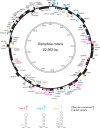Group II Intron-Mediated Trans-Splicing in the Gene-Rich Mitochondrial Genome of an Enigmatic Eukaryote, Diphylleia rotans
- PMID: 26833505
- PMCID: PMC4779616
- DOI: 10.1093/gbe/evw011
Group II Intron-Mediated Trans-Splicing in the Gene-Rich Mitochondrial Genome of an Enigmatic Eukaryote, Diphylleia rotans
Abstract
Although mitochondria have evolved from a single endosymbiotic event, present day mitochondria of diverse eukaryotes display a great range of genome structures, content and features. Group I and group II introns are two features that are distributed broadly but patchily in mitochondrial genomes across branches of the tree of eukaryotes. While group I intron-mediated trans-splicing has been reported from some lineages distantly related to each other, findings of group II intron-mediated trans-splicing has been restricted to members of the Chloroplastida. In this study, we found the mitochondrial genome of the unicellular eukaryote Diphylleia rotans possesses currently the second largest gene repertoire. On the basis of a probable phylogenetic position of Diphylleia, which is located within Amorphea, current mosaic gene distribution in Amorphea must invoke parallel gene losses from mitochondrial genomes during evolution. Most notably, although the cytochrome c oxidase subunit (cox) 1 gene was split into four pieces which located at a distance to each other, we confirmed that a single mature mRNA that covered the entire coding region could be generated by group II intron-mediated trans-splicing. This is the first example of group II intron-mediated trans-splicing outside Chloroplastida. Similar trans-splicing mechanisms likely work for bipartitely split cox2 and nad3 genes to generate single mature mRNAs. We finally discuss origin and evolution of this type of trans-splicing in D. rotans as well as in eukaryotes.
Keywords: Diphyllatia; introns; inverted repeats; mitochondria; trans-splicing.
© The Author 2016. Published by Oxford University Press on behalf of the Society for Molecular Biology and Evolution.
Figures



References
Publication types
MeSH terms
Substances
LinkOut - more resources
Full Text Sources
Other Literature Sources
Research Materials

